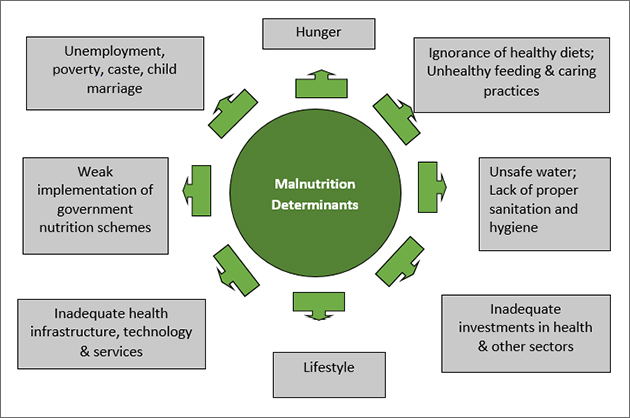Problem of Malnutrition in India
You'll Read
Malnutrition: A Global Epidemic
The estimate of 815 million people enduring chronic food deprivation in 2016, compared to 775 million in 2014, is depressing in itself, but more important is the finding that the deprivation is even greater among people who live in regions affected by conflict and the extreme effects of climate change. In a confounding finding, though, the report says that child under-nutrition rates continue to drop, although one in four children is still affected by stunting.
These are averages and do not reflect the disparities among regions, within countries and between States. Yet, the impact of the economic downturn, many violent conflicts, fall in commodity export revenues, and failure of agriculture owing to drought and floods are all making food scarce and expensive for many. They represent a setback to all countries trying to meet the Sustainable Development Goal on ending hunger and achieving food security and improved nutrition.
What is more, the Centre recently said it had received only 3,888 complaints on the public distribution system (PDS) over a five-year period. All this shows that the Centre and State governments are woefully short on the commitment to end undernourishment.
Undernutrition
- India ranks 114th out of 132 countries in stunting among children aged less than five and 120th out of 130 countries in under-5 wasting, as per the Global Nutrition Report, 2016.
- The burden of vitamin and mineral deficiencies (‘hidden hunger’) is also considerable. This is because a vast majority of Indians eat cereal-based food, mainly wheat and rice. There is an insufficient intake of food such as milk, pulses, and fruits and vegetables, which are rich sources of micronutrients.
- Women and children are the most vulnerable to micronutrient deficiencies.
- Deficiency of iron in women not only reduces physical work capacity and causes fatigue, but could lead to depression and post-partum maternal haemorrhage.
- In children, it impairs growth and cognitive development.
Malnutrition in Tribal People
According to NFHS 2015-16, every second tribal child suffers from growth restricting malnutrition due to chronic hunger. Such acute food insecurity in tribal households is due to a loss of their traditional dependence on forest livelihood and the State’s deepening agrarian crisis. Besides these, systemic issues and a weakening of public nutrition programmes have aggravated the problem.
For example, 20% of tribal families did not receive rations (public distribution system) in Vikramgad (in Palghar, Maharastra) as they did not have a card.
India’s efforts at improving access to food and good nutrition are led by the National Food Security Act.There are special nutritional schemes for women and children operated through the States. In spite of such interventions, 14.5% of the population suffers from undernourishment, going by the UN’s assessment for 2014-16. At the national level, 53% of women are anaemic, Health Ministry data show.
Further, nutrition interventions and tracking progress cannot be done without sufficient information and reliable, updated data, and the operationalisation of a national nutrition surveillance system. Thus, there exists the need to collect and maintain real-time data on various nutrition indicators using ICT and GIS.
Overnutrition
- Over-nutrition is emerging as an emergency in India.
- As per the recent findings of the National Family Health Survey-4 (2015-16), the Body Mass Index (BMI) of 15.5% of urban women was found to be less than 18.5 kg/m2, whereas 31.3% of urban women were in the category of overweight or obese (BMI of or more than 25.0 kg/m2).
- Around 15% of urban men were underweight, while 26.3% belonged to the category of overweight and obese.
- Dramatic changes in lifestyle and dietary patterns in recent decades have contributed to an increasing prevalence of non-communicable diseases. If this double burden of undernutrition and growing percentage of obesity and associated non-communicable diseases is not controlled, it can have serious implications for the economy.
How has this happened?
- While the Green Revolution phase saw new, fast-growing varieties of staples, especially wheat and rice, the following decades saw a steady decline in the food basket diversity, especially of traditional grains such as bajra and millet, which have high nutritional value.
- The 1990s, though, saw a focus on the role of micronutrients. Deficiencies of micronutrients such as zinc, folic acid, magnesium, selenium and vitamin D started receiving more attention.

Way forward
- The Sustainable Development Goal-2, which aims to “end hunger, achieve food security and improved nutrition and promote sustainable agriculture”, is a priority area for India.
- To ensure food and nutrition security, there is a growing need for a multisectoral approach.
- This will not only transform India’s agricultural practices, but also spread awareness about nutritious food among key target groups, including tribals, women and children.
Question for Answer Writing
| Q: While undernutrition remains high in India, over-nutrition too is becoming an emergency. Discuss the causes and consequences of this paradox. |
|---|
You Should Also Read
